Last updated: November 10, 2018
Person
P.G.T. Beauregard

US National Archives and Records Administration
Pierre Gustave Toutant Beauregard was born to a French Creole family on a sugar plantation outside of New Orleans, Louisiana. While studying engineering at the US Military Academy at West Point, he also studied artillery under Robert Anderson, whom he would encounter again under dissimilar circumstances in Charleston in 1861. Beauregard served in the Mexican-American War as an engineer and later held a position as the superintending engineer of the U.S. Custom House in New Orleans.
After his native Louisiana seceded, Beauregard became the first Confederate general officer on March 1, 1861 with the rank of brigadier general. Quickly thereafter, he took command of Confederate forces in Charleston, South Carolina. He found harbor defenses in a poor state despite the energy with which the southerners had erected batteries. He applied his knowledge of engineering and artillery to strengthen Confederate positions.
After President Lincoln’s communication to Governor Francis Pickens of South Carolina that a relief fleet was being sent to resupply Fort Sumter, President Jefferson Davis of the Confederate States of America ordered Brigadier General Beauregard to deliver a final ultimatum to Major Anderson to evacuate Fort Sumter. Beauregard witnessed the bombardment from Charleston, from the Edmonston-Alston House on the Cooper River waterfront, and sent his three aides to seek terms to conclude the battle.
The victor of Fort Sumter, Beauregard followed that success with another victory at the First Battle of Manassas (or Bull Run). Beauregard, later transferred to the Western Theatre because of his disagreements with President Jefferson Davis and other leading Confederates, commanded at the Battle of Shiloh in Tennessee and the Siege of Corinth in northern Mississippi.
Beauregard’s defeat at Corinth resulted in his loss of command of the Western Theatre. The people of Charleston had fond memories of Beauregard from 1861 and clamored for him to take command of their defenses. Beauregard returned to Charleston in 1863 in time to prepare for and defend against repeated Union attacks, beginning in April with a failed Union naval attack. Union General Quincy A. Gillmore directed the failed assaults on Battery Wagner on Morris Island in July. Frustrated, he demanded Beauregard evacuate Morris Island and Fort Sumter or Charleston would be fired upon.
Beauregard never received the letter and vigorously protested Gillmore’s bombardment of Charleston, writing him: “I am surprised, sir, at the limits you have set to your demand. If, in order to attain the bombardment of Morris Island and Fort Sumter, you feel authorized to fire on this city, why did you not also include the works on Sullivan’s and James Islands, nay, even the city of Charleston, in the same demand?” Despite outcry in the Confederacy, Gillmore continued to direct fire upon Charleston.
Beauregard’s valuable experience in commanding a successful defense against besieging Union forces was duplicated in June 1864 when he directed the defense of Petersburg, Virginia, thereby safeguarding Richmond.
Following his military career, Beauregard was one of the few wealthy former Confederate generals because of his role in promoting the Louisiana Lottery. He died in 1893 and is buried in New Orleans in the tomb of the Army of the Tennessee.
